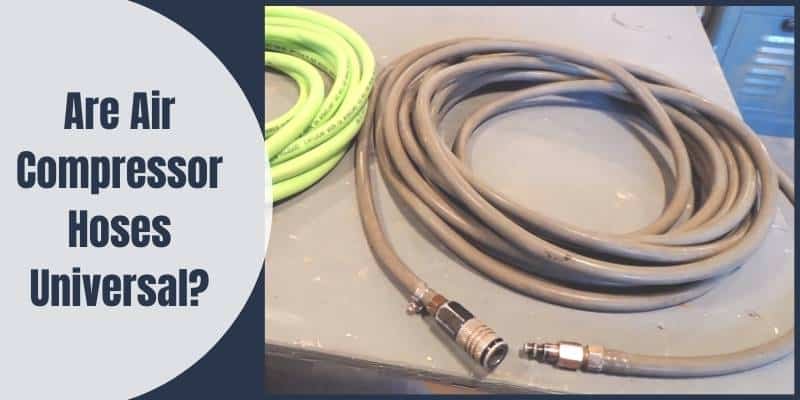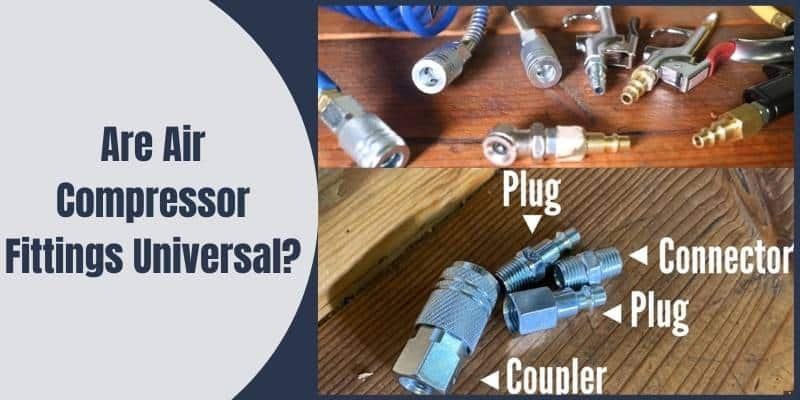Disclosure: This post contains affiliate links and I will be compensated if you make a purchase after clicking through my links. Learn More
Have you ever reached for an air hose only to find the threads won’t fit your compressor? Or tried connecting a new hose to an old tool but couldn’t get a tight seal? It’s a common assumption – air hoses are universal. But in reality, looks can be deceiving. Even hoses that appear the same may not connect.
Before grabbing a hose, it’s important to know they are not one-size-fits-all. Factors like thread types, pressure ratings, and material change compatibility. This article will explain the key things to look for when selecting hoses. You’ll learn why air hoses aren’t universal and save yourself time, money and frustration down the road.

Are Air Compressor Hoses Universal?
Air compressor hoses are generally not universal. In most cases, an air compressor hose should be matched to the specific air compressor model for proper fit, pressure rating, and safety. Universal adaptors can sometimes be used to connect mismatched hoses.
There are different types of air compressor hoses that have incompatible fittings and are designed for different pressure ratings. Factors that determine hose compatibility include:
Hose Materials
The material of an air compressor hose plays a crucial role in its compatibility. Common materials include rubber, PVC, and polyurethane. Each material has distinct properties that affect its performance. Rubber hoses, for instance, are durable and flexible, making them suitable for a wide range of applications. PVC hoses, on the other hand, are lightweight but may not withstand extreme temperatures as well as rubber hoses.
Hose Sizes
Hose sizes vary, and selecting the right one is vital to ensure compatibility with your air compressor. The most common hose sizes are 1/4-inch, 3/8-inch, and 1/2-inch. The size determines the volume of air the hose can handle. Smaller hoses are suitable for lighter tasks, while larger ones are ideal for heavy-duty applications. Always check your compressor’s specifications to match the hose size accordingly.
Coupling Types
The coupling is the part of the hose that connects to the compressor and the tools. Couplings come in various types, such as quick-connect, industrial, and automotive. It’s essential to choose a hose with couplings that match your compressor and tools.
Quick-connect couplings are relatively universal and can be used with various hoses and tools. Also convenient for fast changes between tools, while industrial couplings offer durability and stability.
Pressure Rating
Every air compressor has a specific pressure rating, usually measured in pounds per square inch (PSI). It’s crucial to select a hose that can handle the maximum PSI of your compressor. Using a hose with a lower pressure rating can lead to safety hazards and reduced efficiency.
Length
Hose length is another consideration when it comes to compatibility. Ensure your hose is long enough to reach your work area comfortably. However, avoid using excessively long hoses, as they can lead to pressure drop, affecting your tools’ performance.
Temperature Range
Consider the temperature range in which you’ll be using your air compressor. Some hoses are designed to withstand extreme temperatures, while others may become brittle or too flexible in extreme conditions. Always choose a hose rated for the temperature range you anticipate.
Some Important FAQs About Air Compressor Hoses
Are All Air Compressor Hoses the Same Size?
No, all air compressor hoses are not the same size. There are three main hose sizes (the diameter) used in large numbers, but there are a few others. The most common hose diameter sizes are:
-1/4 inch hose
-3/8 inch hose
-1/2 inch hose
The most common type of air hose is the 1/4-inch variety. It is typically used to power smaller, hand-held pneumatic tools like nail guns and staplers. A 3/8-inch air hose is slightly larger in diameter than a 1/4-inch hose and is often used to air impact wrenches and other mid-sized pneumatic tools.
A 1/2-inch air hose is the largest diameter available for most applications. These heavy-duty hoses are used for large volume applications such as powering sanders and paint sprayers.
It is important to select a hose that is compatible with the type of air compressor you have as well as the type of air tool you intend to use.
How Do I Know What Size Air Hose to Buy?
When it comes to air hoses, size does matter. But how do you know what size air hose to buy? The answer depends on a few factors, including the specific application you have in mind, the type of compressor you’ll be using, and the length of hose you need.
Here are a few general guidelines to help you choose the right size air hose:
For most applications, a 1/4-inch or 3/8-inch air hose will suffice. If you’re using a more powerful compressor or running longer lengths of hose, then you may need a 1/2-inch or larger air hose.
The most important factor in choosing the right size air hose is your compressor. Make sure to check the CFM (cubic feet per minute) rating of your compressor to ensure it can handle the volume of air flow your application requires. For example, if you’re using an airbrush with a small cup and needle assembly, then you won’t need as much CFM as someone who’s spraying paint from an aerosol canister.
In general, most compressors can provide between 4 and 8 CFM at 90 PSI. It’s always best to consult your specific model’s documentation for accurate numbers. Once you know your required CFM rating, look for an air hose that has a similar rating (or higher). This will ensure that your compressor can provide enough power to run your tools properly without overworking itself.
It’s also worth noting that some tools require more CFM than others; for example, air sanders tend to require more CFM than impact wrenches. So if you’re unsure about which size air hose to get, err on the side of caution and go with a larger diameter option. Finally, consider the length of air hose you need for your application.
Does Hose Diameter Matter for Air Compressor?
Yes, the diameter of the air compressor hose matters significantly. The hose diameter affects the volume of air that can flow through it. Smaller diameter hoses restrict airflow, potentially leading to reduced tool performance. On the other hand, larger diameter hoses allow for greater airflow and are suitable for high-demand tools that require more air.
Is Hose Diameter Measured Inside or Outside?
Hose diameter is typically measured on the inside. This measurement, known as the inner diameter (ID), directly impacts the airflow capacity of the hose. Common hose diameters for air compressors include 1/4-inch, 3/8-inch, and 1/2-inch.
How Do You Measure an Air Compressor Hose?
To measure the inner diameter of your air compressor hose accurately, use a caliper or a hose measuring tool. Simply place the measuring device inside the hose and record the measurement. Knowing the hose’s inner diameter will help you select the right size for your needs.
Does Hose Size Affect Air Pressure?
Absolutely, hose size has a direct impact on air pressure. Smaller hoses create more resistance to airflow due to their limited capacity. This resistance can result in a drop in air pressure, affecting the performance of your pneumatic tools. Conversely, larger hoses minimize this resistance, allowing for higher air pressure and better tool performance.
What Size Hose Gives the Best Pressure?
The ideal hose size for maintaining the best air pressure depends on your specific application and air compressor capacity. In general, larger hoses with a diameter of 3/8 inch or more are suitable for high-demand tasks, as they allow for greater airflow and less pressure drop. However, for lighter applications, a smaller hose with a diameter of 1/4 inch may provide sufficient pressure.
What PSI is a Standard Hose?
A standard air compressor hose typically has a working pressure rating of around 300 PSI (pounds per square inch). This rating ensures that the hose can safely handle the pressure generated by most common air compressors. It’s essential to check the hose’s PSI rating to ensure it matches your compressor’s output.
Can I use any hose with my air compressor?
While you can’t use just any hose, you have options. Ensure the hose material, size, and pressure rating match your compressor’s requirements.
What are the benefits of rubber hoses over PVC?
Rubber hoses offer better durability and flexibility, making them suitable for a wide range of applications, including heavy-duty tasks.
Can I extend my hose length for more flexibility?
You can extend hose length, but be cautious not to go too long, as it may result in decreased air pressure and tool performance.
How do I store my air compressor hose properly?
Coil the hose neatly and store it in a cool, dry place away from direct sunlight to prevent damage.
Wrapping Up
If you’re working with an air compressor, you need to have the right hose to go along with it. Otherwise, you won’t be able to use your air compressor properly. If the hose is too small, the airflow will be restricted and your tools won’t work as well. If the hose is too big, it can become kinked or damaged easily.
So, are air compressor hoses universal? Well, you already know the answer!
Read also: Are Air Compressor Fittings Universal?
Hopefully, by reading this article you have got a clear understanding of air compressor hoses. Finally, don’t forget to take good care of your air compressor, and get it checked periodically. It’s essential for both your machine and your personal safety. Have a great day!


